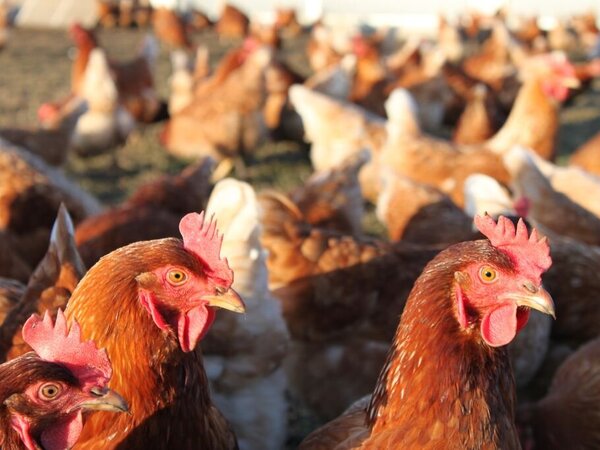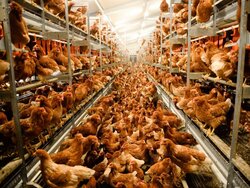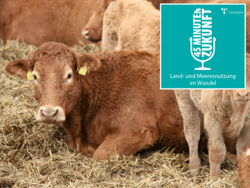Dossier
National Livestock Strategy
Folkhard Isermeyer | 30.06.2022
German livestock farmers are caught in a dilemma that will sooner or later threaten their existence: On the one hand, they are exposed to international competition and have to produce at world market conditions; on the other hand, they are denounced as "factory farmers" and have to meet ever higher animal welfare and environmental standards.

Is there a way out of the crisis? The supposedly simple solutions would not work. "Rejecting cheap imports at the external border" fails because of the EU common market and WTO rules. "Relying on consumers' voluntary willingness to pay" changes only a (small) part of the whole market. "Tighten the legal regulations" has been pursued for a long time, but only half-heartedly, because too much tightening would push livestock farming abroad. "Relying on EU-wide regulations" fails because the issue of animal welfare is assessed quite differently in different regions of the EU.
The "Competence Network Livestock Husbandry", better known as the Borchert Commission, submitted a scientifically based proposal for a solution to the Federal Ministry of Agriculture in February 2020. Business represantatives, environmental and animal protection associations have pleaded for a rapid implementation of the proposals. The German Bundestag has passed a resolution to this effect. In the meantime, the Federal Ministry of Agriculture has received a feasibility study and a policy impact assessment on the farm animal strategy. Both studies confirm that the Borchert Commission's proposals can be implemented and offer the opportunity to raise Germany's entire livestock sector to a significantly higher level of animal welfare. The Borchert Commission is working on specifying the criteria for animal welfare levels for the different animal species. Incidentally, it is now up to the politicians to set the course for the future of farm animal husbandry.
The path travelled so far shows: Science can achieve a lot if it (a) works on a societal problem consistently, solution-oriented and persistently and (b) devotes sufficient energy to representing its findings in discussions with business, civil society and politics.
The following section traces the stages in the development of the national farm animal strategy over the past 20 years. The respective documents are available for download.
With open external borders, how can national animal husbandry be successfully differentiated from the "global mainstream" and more closely aligned with societal expectations? This question was already addressed by federal research when Federal Minister Renate Künast propagated the agricultural turnaround in 2001. The proposed solutions published at that time are still valid today. Two publications from that time are once again made available for download here. This is also because in recent times science has repeatedly been reproached for having first advocated trade liberalisation and "now suddenly" changing course with regard to livestock farming. This does not correspond to the truth.
- Die Agrarwende – was kann die Politik tun?Folkhard Isermeyer, 2001, Braunschweig (in German)
- Wer bezahlt den Tierschutz?Folkhard Isermeyer, Lars Schrader, 2003, Landbauforschung Völkenrode, Sonderheft 262: 151-174 (in German)
In 2012, an expert forum of the German Agricultural Research Alliance (DAFA) published the research strategy for farm animals "Science, Economy, Society - Together for Better Animal Husbandry". This shows what research is needed to achieve the core goal of a measurable improvement in German farm animal husbandry (with respect to societal expectations). The consistent goal orientation of this strategy led to the then surprising result that research should not be limited to the "classic" research fields of animal breeding, animal husbandry, etc. alone, but must extend the arc further: How can societal expectations of livestock farming be captured in concrete terms? How should indicator-based monitoring be designed? How should policy deal with the regional concentration of livestock farming? The strategy was not conceived as a finished work, but as a continuous collaborative learning process.
With the support of the BMEL, 18 scientists from all over Germany evaluated the progress made from the end of 2017 onwards and derived conclusions for future research funding. This showed that despite many successful research projects, not enough progress had been made with regard to the core objective of "measurable improvement of German livestock farming".
The experts recommend that research be directed particularly towards those areas that were identified as deficient in the interim assessment. For the establishment and evaluation of new production systems with a focus on animal welfare and climate protection, corresponding experimental farms ("stables of the future") are of central importance, which must be continuously financed and scientifically accompanied. Livestock farms also need not only clear guidelines and financial support for the conversion of their housing systems, but also building and environmental permits and a reliable promise that new and innovative stables can be operated for a sufficiently long time.
- Livestock Expert Forum: Science, economy, society – working jointly towards improvements in animal husbandryStrategy of the German Agricultural Research Alliance
- Fachforum Nutztiere: Fortschrittsberichte zu den Clustern Deutsche Agrarforschungsallianz, 2019, (in German)
- Fachforum Nutztiere: Zwischenbilanz nach sieben JahrenDeutsche Agrarforschungsallianz, 2019, (in German)
In March 2015, the Scientific Advisory Council for Agricultural Policy at the Federal Ministry of Food, Agriculture and Consumer Protection (BMEL) published its report "Pathways to a socially accepted livestock husbandry in Germany". The report offers a comprehensive analysis of all aspects of this very broad topic. It covers everything from social perception, consumer behaviour and the various problem areas (animal welfare, environmental protection, etc.) to the various possible solutions. Among the possible solutions, special attention is paid to the question of financing. The financial requirements for the implementation of the proposed guidelines are estimated to be in the order of 3 to 5 billion euros per year, corresponding to an increase in the relevant consumer prices in the order of 3 to 6 percent. The report culminates in numerous recommendations (immediate and medium-term measures) addressed to various actors (EU, federal government, Länder as well as business).
In 2014, 2015 and 2016, the president of the Thünen Institute, Folkhard Isermeyer, presented three publications in which he outlined the need for a national farm animal strategy. The first publication (2014) has two main focuses: Firstly, it sorts out the diverse activities that politics and business have already taken. The result: they are not coordinated with each other, and in some cases they may even hinder each other. Secondly, it is suggested that a farm animal strategy should not only focus on the issue of "animal welfare", but should include all aspects that play a role in the social debate on "factory farming".
In later publications, the core elements of a farm animal strategy are gradually elaborated. It becomes clear that the federal government would have to play the main role here and that a fundamental decision regarding funding is necessary. One funding option is tax revenue; in this case meat would remain cheap for consumers and farmers would receive a second income from the state for their "animal welfare" service. In the other option (financing by consumers), the state would primarily have the task of providing orientation by declaring the socially desirable husbandry methods and encouraging the trade to gradually orient its range towards the high-quality products.
- Plädoyer für eine nationale Nutztier-StrategieFolkhard Isermeyer, 2014, Agra Europe (41):1-15 (in German)
- Plädoyer für eine nationale Nutztier-Strategie:Wie kommen moderne Landwirtschaft und Gesellschaft wieder zueinander? Folkhard Isermeyer, 2015, Agra Europe (36):1-4 (in German)
- Landwirtschaft im Spannungsfeld zwischen Weltmarkt und kritischer BevölkerungFolkhard Isermeyer, 2016, Agra Europe (8):1-5 (in German)
- Interview : „Wir brauchen eine NutztierstrategieFolkhard Isermeyer, 2016, Top Agrar (4):14-15 (in German)
In 2018, the governing parties in the German Bundestag announced their intention to establish a state labelling system (animal welfare label). In addition, investments in animal welfare stables were to be financially supported. The announcements of the parties in spring/summer 2019 went in different directions: Some favoured a voluntary label, others a mandatory one.
In Thünen Working Paper 124, Folkhard Isermeyer elaborated that the question of "voluntary or mandatory labelling?” misses the core of the problem. If a farm animal strategy aims to significantly raise animal welfare across the national industry, neither option is suitable to serve as a central funding element of this national farm animal strategy. Instead, in addition to investment support, the policy should introduce an annual animal welfare premium paid to all farmers who bring their farming system up to the socially defined animal welfare level and meet certain criteria (e.g. in the area of animal health).
Based on this core result, Isermeyer developed a step-by-step plan that outlines the main features of a national farm animal strategy. In the discussion, he addressed questions that are often raised in political debates. For example: Why national and not EU? Why farm animal husbandry and not agriculture as a whole? What is the role of product labelling? Can the concept be undermined by cheap imports? Does it comply with EU regulations?
At the beginning of April 2019, the Federal Ministry of Agriculture set up the "Competence Network Livestock Husbandry". Chaired by the former Federal Minister of Agriculture, Jochen Borchert, it brought together decision-makers and experts from politics, science, practice, business and associations. The task of the committee was to develop solutions that combine more animal welfare, environmental protection and economic efficiency for farmers and consumers.
In February 2020, the competence network presented its recommendations. These provide for a fundamental and long-term restructuring of German livestock farming - towards more animal welfare and environmental protection. The restructuring is to take place step by step and animal-specific until 2040. The Borchert Commission estimates the additional costs of animal welfare production in the final stage at 3.6 billion euros per year.
Since this additional amount cannot be raised through voluntary payments by consumers (labelling) and farmers need planning security, the Commission proposes to compensate for the higher costs of animal-friendly husbandry methods with a combination of animal welfare premiums and investment support. Planning security is to be achieved with the help of contracts that the state concludes with farmers. The additional financial requirements of the federal budget could come from an excise tax on animal products, for example 0.40 €/kg of meat, 0.02 €/kg of milk and eggs and 0.15 €/kg of cheese, butter and milk powder.
- Borchert-Kommission: Empfehlungen des Kompetenznetzwerks NutztierhaltungBundesministerium für Ernährung und Landwirtschaft, 2020 (in German)
More animal welfare for all farm animals by 2040 - with the help of the proposals of the “Competence Network Livestock Husbandry”, this goal can be achieved in German stables. The Thünen Institute has investigated what additional costs arise due to animal welfare and how they can be covered, how high the need for subsidies for agriculture is and what economic effects the targeted transformation process will have.
With the impact assessment for policy makers, concrete calculations are now available on how the proposals of the " Competence Network Livestock Husbandry " can be implemented.
Using typical farms as examples, the scientists have worked out how the farms have to be converted in detail in order to fulfil the criteria of the respective animal welfare levels and what additional costs these adaptations cause. Labour input, higher-quality materials such as straw as bedding, fewer animals in the barns and, in some cases, lower animal performance result in 10 to 20 percent higher production costs for most animal species.
However, by means of investment support, animal welfare premiums and state product labelling, farms can be put in the economic position of being able to transform their animal husbandry to a high level of animal welfare and remain competitive in the process.
- Thünen Working Paper 173Politikfolgenabschätzung zu den Empfehlungen des Kompetenznetzwerks Nutztierhaltung (in German)
A new federal government came into power in autumn 2021. How this government will deal with the recommendations of the Borchert Commission and whether this Commission should be continued cannot be foreseen at present. If the core of the concept is implemented (minimum: investment promotion and animal welfare premium for the long-term target images of livestock farming), the gradual transformation of the entire livestock sector with regard to the goal of "animal welfare" would be politically secured. However, this is not sufficient for a comprehensive farm animal strategy. A national livestock strategy must also address the question of how many livestock should be kept at which locations in the future. This question was not part of the mandate of the Competence Network. To answer it, the requirements of climate and environmental protection would have to be taken into account above all, and a vision would have to be created of how land use structures and value creation in rural regions should develop.









